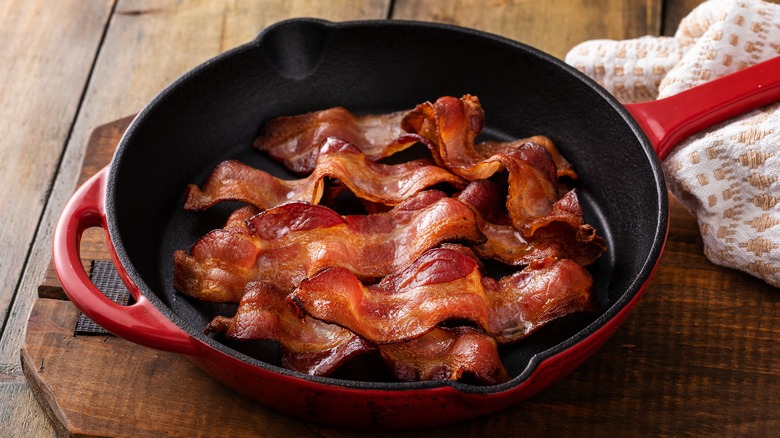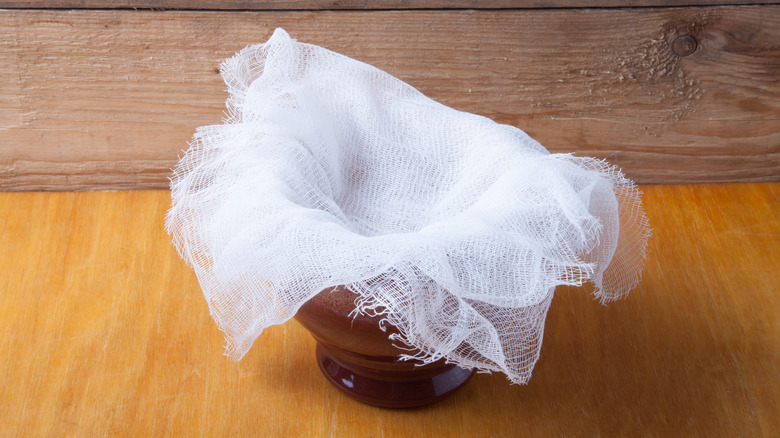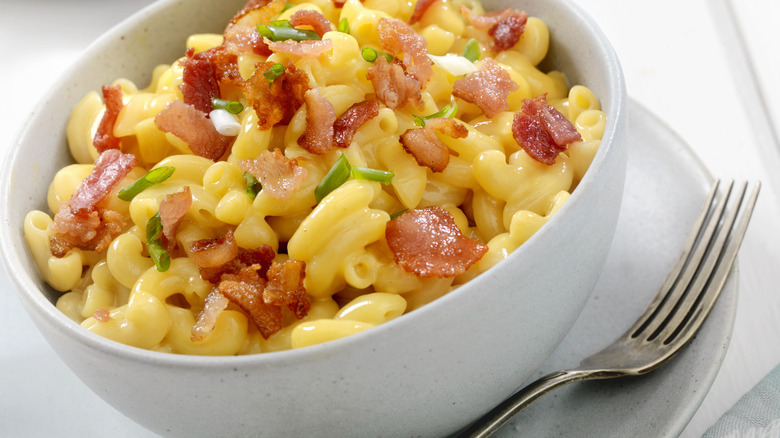Cheesecloth Is The $5 Secret To Getting More From Your Bacon Batch
Waste not, want not — this mantra can be applied to every part of your living space, including your kitchen. Stretching your cooking scraps is one of the most effective ways to do so. That might mean making a batch of stock from a roasted chicken carcass or veggie scraps, or making potato chips out of the peels. It also means that you shouldn't throw away your bacon grease.
You probably already know that you shouldn't pour bacon grease into the sink, but don't let it go down the metaphorical drain, either. By using a piece of cheesecloth to strain out residual bacon bits, then storing the rendered grease in the fridge, you'll have a reliable source of flavorful fat that's a serious asset in the kitchen. Straining the fat is a must-do to help the grease keep for longer: Fat is bacteria-resistant, but if there are bits of meat or other debris in it, it will deteriorate much faster.
Whether you're cooking bacon on the stove or in the oven (the best way), it's very easy to save the grease. Simply drape your cheesecloth over an airtight vessel — one that won't melt, so no plastic — and pour the fat from your pan into the cloth. Let the fat drain through the breathable material, wait for it to cool at room temp, and store it for three months in the fridge or indefinitely in the freezer. You'll know it's time to throw it out if it smells rancid.
Why use cheesecloth to strain bacon fat?
You might be tempted to reach for a metal sieve to strain your bacon grease, but there are a few good reasons to use cheesecloth. First of all, cheesecloths are easy to find and reusable. They can be picked up from most grocery stores or online markets like Amazon, usually running at about $5 per piece. Your cloths will need to be cleaned thoroughly between uses in order to remain food-safe, but the process is easy.
If you use a fine-mesh metal strainer for bacon grease, you might need to run it through the dishwasher over and over just to get the fat out of the small holes. Why is cheesecloth superior to paper towels or a paper coffee filter, as well? These options are single-use; prone to ripping; and the grease will take longer to filter through. Also, remember that paper towels are absorbent, so they may soak up too much grease and rob you of your porky prize.
To wash a used cheesecloth, rinse it thoroughly with hot water to remove any bacon debris. It can then be cleaned in your washing machine (inside a laundry bag with a delicate cycle), or by hand. Use mild detergent for either method and dry the cloths completely before storing them. Even with after a thorough washing, a bacon flavor may still remain in the cotton fibers, so try to keep a designated bacon cheesecloth and don't use it for other purposes.
How to cook with your bacon grease
Wondering how to use your nifty stash of bacon grease? You should know the grease isn't quite the same as lard. Though lard is also made of pig fat, it isn't cured like bacon is, and has more of a neutral taste. Bacon grease is smokier and saltier, so it can't always be used in place of pure lard. The good news is that this same flavor is what makes bacon fat so delicious — it's a much stronger flavor booster than regular old pig fat.
Bacon pretty much tastes good with everything (it's science), and southern cooks will be the first to tell you that you must try cooking with the grease. Classic recipes like cornbread, collard greens, cream gravy, or southern-style green beans all put this porky gold to use as a flavorful foundation. But don't stop there! Stir some fat into the cheese sauce for mac and cheese, roast vegetables in the grease, cook up home fries with it, or make a warm bacon vinaigrette for a simple green salad.
To get even more creative, try fat-washing some bourbon to make cocktails with a smoky, salty twist, or replace some of the fat in your baked goods with bacon grease for an umami-packed layer of flavor. Go hog wild, so to speak — and any time you run out, just grab your cheesecloth and prepare a fresh batch.


